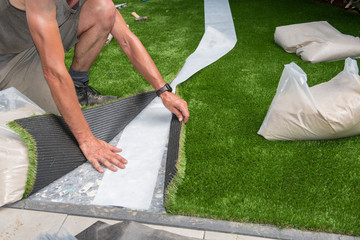Artificial grass has become a very popular choice for landscaping in homes, schools, businesses, parks, and many other places. Often called artificial turf or fake grass, artificial grass really looks very similar to natural grass, without any of the disadvantages of real natural grass. In fact, it can be installed almost anywhere you like, right down to gardens and sidewalks! The only drawback to using fake grass is that it does not provide as much visual impact as real grass would. It is much more forgiving of minor imperfections such as splinters or bald spots. However, there are several ways artificial grass can be adjusted to improve its appearance.
With the increase in awareness of eco-friendly landscaping, more homeowners and business owners have been considering artificial turf for decorating their yards. Since it has become so affordable, many companies have added features and options to create a true “green” look that mimics natural grass, giving your yard the appearance of a full, thick grass field. Artificial turf is now made of many different materials including polyethylene, high definition micro-organisms, and thermoplastic.
You will need to make sure that your fake grass manufacturer uses renewable resources and creates durable products so that they will last for years to come. For instance, if you live in an area where it snows, you might consider a manufacturer that offers a durable finish, such as thatch. There are some different types of thatch, including non-ablative (the material doesn’t harden when applied to the surface) and thermoplastic thatch. Most artificial turfs include thatch for several reasons – to mimic the look of wood, to reduce erosion, and to allow water to percolate into the base material. However, some artificial turf manufacturers use thatch to create a thicker, more durable look.
If you do choose to use thermoplastic thatch, you will find that it adds a unique texture and appearance to your lawn. For instance, if you order synthetic grass for your walkways and pathways, you can also choose a thermoplastic thatch that looks just like wood grain. If you prefer the look of real grass but don’t want to deal with maintenance issues, you can still use artificial turf as a substitute – you can purchase fake grass that looks similar to native grass.
Artificial turf has many advantages over natural grass, but there are some disadvantages as well. For instance, while fake grass is more durable than natural grass, it is not environmentally friendly. While some companies use only recycled plastic in their fake grass products, other companies go with virgin vinyl. This type of plastic is much more durable and requires less maintenance, making it a better overall choice. However, you can create your own “artificial turf” by planting grass clippings and other natural materials in the ground to mimic the look of turf. Even if you go with a natural look, you can still choose to make your artificial grass completely organic.
Another disadvantage to using artificial grass for your yard is that it can be a health issue for pets and children. The material can collect dust and other residues from feet, causing allergies and asthma attacks in these individuals. Additionally, there is evidence that people who suffer from respiratory illnesses such as asthma have been negatively affected by synthetic grass. Regardless of whether or not it is a genuine grass alternative, artificial turf can be an unnecessary addition to your lawn. It certainly doesn’t offer the same benefits to your lawn that natural grass does, which is one reason why many homeowners turn to alternatives.
A final consideration when you consider the environmental impact of artificial turf is the fact that you may be using pesticides and other chemicals to keep it looking its best. While some companies do use natural fertilizers and pesticides to maintain their fake grass systems, you have the responsibility to ensure that any chemicals you are using are completely non-toxic. To make this even more important, it is strongly recommended that you choose your supplier carefully and perform your due diligence by checking with your state department of agriculture to ensure that the chemicals used will not be harmful to your plants. This is especially true if you live in a region that is known for having issues with harmful chemicals.
Overall, fake grass has its advantages and disadvantages, but it is up to you to determine if synthetic grass is the right choice for your home or business. Do your research, get Fake Grass professional recommendations, and read the ingredients in the synthetic products to ensure that you are getting what you want. If you’re comfortable with the decision, go ahead and set up your artificial lawn. But remember that it’s an investment in your yard. Make sure you get quality materials and install them properly so that you can enjoy your new lawn for years to come. Synthetic grass may be cheap initially, but in the long run, it can save you money and keep your maintenance costs down.
